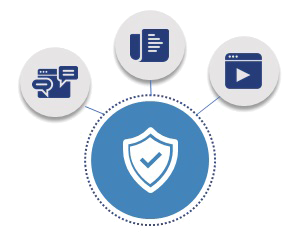Higher Education Leading the Way in Identity Management

Download our higher education case study here.
Reliable identity and access management (IAM) models enable the deployment and use of applications and information with significantly greater protection than what traditional perimeter security provides. IAM ensures that authorized users have the appropriate access to appropriate information assets. The security solution has been around for a long time, in some shape or form, to help organizations limit access to sensitive information and critical systems.
Simply put, IAM in enterprise IT entails defining and managing roles and access privileges of individual network entities, including users and devices, to the different cloud and on-premise IT assets. Users, in this case, include customers, employees, consultants, and partners, while devices include computers, laptops, smartphones, network equipment, servers, and IoT sensors.
Modern IAM Model in Higher Education
Unlike commercial enterprises that supply devices and increasingly support and monitor users, the higher education sector is leading the way in marginalizing this traditional IAM approach. Institutions of higher learning essentially allow their attending populations to supply their technology in their IAM programs.
Higher education ecosystems feature youthful, internationally distributed, and increasingly online populations with various devices and applications accessing university networks and systems. College IT environments heavily encompass technologies like cloud computing, mobility, and smartphones with a wide range of applications.
Higher education has turned to authentication systems to manage students' and tutors' identities and accounts across systems. In a campus setting, numerous information systems, such as learning management solutions, email, library systems, and computing applications, require students and professors to authenticate themselves, typically by providing a username and password. Fortunately, the latest IAM solutions provide unmatched capabilities for the new world of extensively distributed access.
Some popular solutions in this area include full-featured, industry-proven identity as a service (IDaaS) solutions. Such enterprise programs determine which IT resources an authenticated user is permitted to access. Aside from that, the solutions allow users to employ a single digital identity across all resources they are entitled to.
Unique IAM Challenges in Higher Education
On top of connecting various devices and services that dwarf even large enterprises, higher education institutions have unique IAM challenges. With nearly all IAM systems focusing on commercial enterprise use cases out of the box, addressing higher education IAM requirements can be considered ad-hoc. Developing reliable and future-proof solutions for the sector requires an understanding of their unique challenges.
1. Transient Students and Staff
First, universities and colleges deal with transience on a massive scale. Typically, learners and tutors flow in and out of school systems, sometimes taking semesters off before resuming or never recommencing completely. Indeed, higher education experiences a revolving door of user identities that requires IT departments to handle complex transient and massive user identities.
2. Strict IT Budget Guidelines
Beyond managing many identities, universities must operate their IAM within stricter IT budget guidelines. A recent post mentioned that governments keen to balance budgets cut post-secondary funding, which will hurt the economy, innovation, and research in the long term. One of the affected areas is Canada's higher education, which faces a financial crisis. Besides, the ongoing COVID-19 pandemic has adversely affected tuition funding sources, particularly from international students. Having to operate with less funding than before means that many universities will have to delay innovation until the situation improves, with IT departments making more significant cuts.
3. Highly Sensitive Data in Higher Education
Apart from budget constraints, institutions of higher learning must protect highly sensitive personal, financial, research, and academic information. Universities collect and manage data with varying degrees of sensitivity, ranging from student and employee personal records to research data. Institutions must categorize and prioritize their information to determine the necessary security technologies to enhance protection.
4. Regulatory Compliance
Higher education must comply with multiple government and sector regulations. Universities must comply with Canada's data protection law, which comprises a "complex set of federal and provincial statutes." Additionally, industry-based regulations like GDPR, HIPAA, and PCI DSS mandate more robust security measures to counter rising cybersecurity threats.
5. Rising Cyber Incidents in Universities
Meanwhile, the sector is inherently prone to security concerns. A recent report showed that 1,327 data breaches in the education sector had resulted in the exposure of 24.5 million records since 2005, with higher education accounting for three-quarters of the incidents. In one of the attacks, hackers compromised data in eight universities in the US, Canada, and the UK by launching ransomware. In a different incident, Burnaby-based Simon Fraser University alerted students and staff that cybercriminals breached data containing their personal information.
KeyData and SailPoint Sponsored CANHEIT 2021
As active supporters of the higher education community, KeyData and SailPoint sponsored CANHEIT 2021 last week. CANHEIT 2021 is the largest virtual gathering of Canadian higher education IT leaders from universities, colleges, technical institutes, and security was a key topic for the 5-day event.
Outsource IAM Solutions for Best Outcomes
Needless to say, mobile and cloud computing will continue to gain popularity in higher education. Users will increasingly use cloud services like Google Apps and Microsoft programs. At the same time, hackers will continue exploiting vulnerabilities in these applications, resulting in substantial impact data breaches.
On the service provider's side, they understand that students have high expectations for ease of use and top-tier usability.
Traditional IAM solutions developed during a different IT era characterized by on-premise networks and homogenous system environments (primarily Windows and Linux) do not work efficiently with today's IT landscape that features a myriad of web applications. Higher education can deploy unified IAM models that centralize identity management in a single cloud-based platform.
Considering the challenges IAM faces in higher education, it is inevitable that home-based solutions will not keep pace. Institutions of higher learning require in-house expertise, infrastructure resources, and licenses to build reliable IAM solutions. What's more, universities developing the solutions in-house require experts to maintain the solution, provide incremental integration, train and support users.
The best course of action for universities and colleges is to leverage outsourced alternatives, eliminating most on-premise infrastructure requirements. This means that the solutions provider handles all the maintenance and management requirements, while higher education IT admins simply populate their user populations and connect them to the IT assets they need to access.
KeyData, a recognized industry leader in IAM services, provides a full range of end-to-end IAM solutions, including IAM consulting and professional services for systems integration. Higher education can partner with KeyData to significantly save time and money by eliminating the huge capital expenditure and management overhead required to build and maintain similar in-house IAM solutions. Users also benefit from having one identity across an array of IT resources, such as on-premise applications, productivity platforms, systems and services, cloud applications, and wired and Wi-Fi networks.





